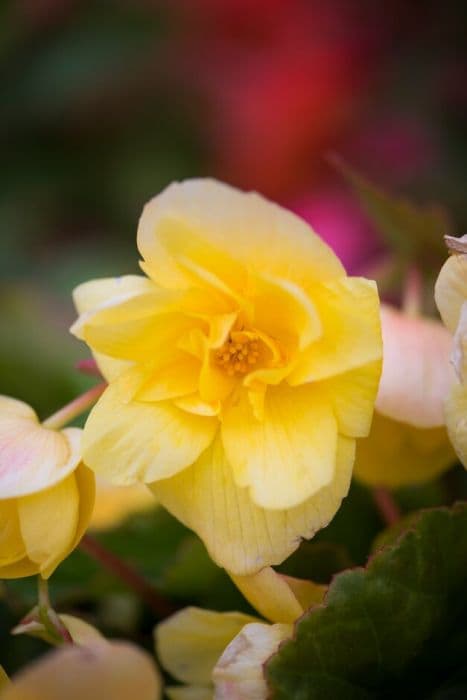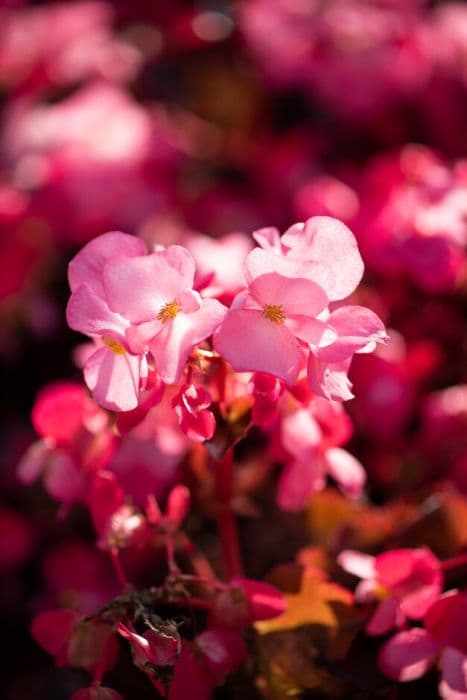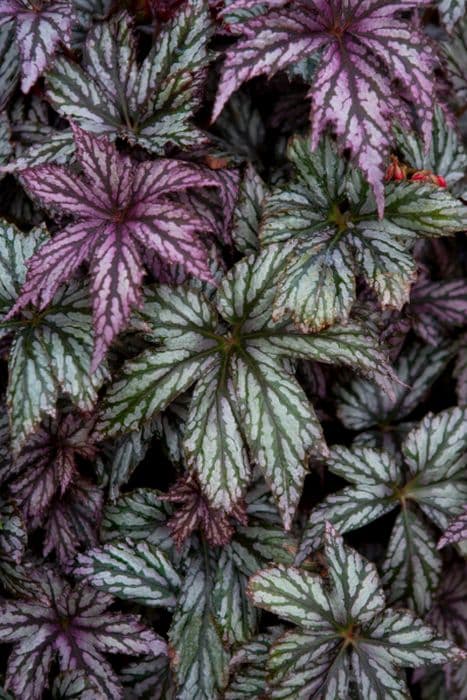Wax Begonia Begonia (Superba Group) 'Irene Nuss' (C)

ABOUT
The Begonia 'Irene Nuss' is a striking plant, noted for its vibrant foliage and flowers that add a splash of color to any environment where it grows. The leaves of this plant are particularly eye-catching, often large with a lush, waxy surface that glistens as if it were polished. Their color is typically a deep green, and they may show a reddish or maroon underside, which creates a stunning contrast against the brighter elements of the garden. The flowers of 'Irene Nuss', like other members of the Superba Group, are showy and flamboyant. They bloom in clusters, showcasing a plethora of petals that can range in color. These blooms are celebrated for their long-lasting quality and often appear throughout the warmer seasons. Texture is an essential aspect of this plant’s charm, with the foliage and flowers both presenting a delightful tactile experience. The soft but firm petals invite gentle touching, while the leaves display a hearty robustness. In terms of the plant's growth habit, 'Irene Nuss' tends to be bushy, with stems that can be both upright and trailing, depending on the environment and care. This growth pattern allows it to fill its space with a sense of fullness and vitality, oftentimes creating an almost cascading effect that is quite attractive in hanging baskets or when allowed to spill over the sides of containers. Overall, the Begonia 'Irene Nuss' is a plant full of charm, with its mix of splendid foliage and vivid flowers. It stands out for its ornamental qualities, and although its size can be substantial, it is the plant's visual impact that truly makes it a prized possession for gardeners and plant enthusiasts alike.
About this plant
 Names
NamesFamily
Begoniaceae
Synonyms
Irene Nuss Begonia
Common names
Begonia 'Irene Nuss'.
 Toxicity
ToxicityTo humans
Begonias, including the 'Irene Nuss', generally contain oxalate crystals, which can be irritating if ingested. In humans, consuming parts of the plant may lead to symptoms like burning and swelling of the mouth, lips, tongue, and throat. It can also cause nausea, vomiting, and difficulty swallowing. In severe cases, it might lead to breathing difficulties due to swelling in the throat, but this is rare.
To pets
Begonias, including the 'Irene Nuss', are similarly toxic to pets due to the presence of insoluble oxalates. If a pet ingests part of this plant, symptoms such as oral irritation, excessive drooling, vomiting, and difficulty swallowing may occur. In more serious cases, it may also lead to swelling of the oral cavity and throat, which can cause breathing difficulties. It is important to prevent pets from chewing on or ingesting this plant.
 Characteristics
CharacteristicsLife cycle
Perennials
Foliage type
Evergreen
Color of leaves
Varies
Flower color
Pink
Height
1-2 feet (30-60 cm)
Spread
1-2 feet (30-60 cm)
Plant type
Herb
Hardiness zones
10
Native area
Central and South America
Benefits
 General Benefits
General Benefits- Aesthetic Appeal: Adds vibrant foliage and colorful flowers to gardens or indoor spaces, enhancing visual beauty.
- Low Maintenance: Has minimal care requirements, making it suitable for busy individuals or novice gardeners.
- Durability: Exhibits resilience in appropriate growing conditions, with resistance to common pests and diseases.
- Versatility: Suits various garden designs, from container gardening to bedding plant arrangements, thanks to its compact growth habit.
- Seasonal Interest: Offers season-long blooms, providing consistent color throughout growing months.
- Pollinator Friendly: Attracts beneficial insects like bees and butterflies, promoting biodiversity in the garden.
- Mood Enhancement: Presence contributes to a relaxing and joyful environment, potentially improving mental well-being.
- Cultural Significance: Holds a place in traditional gardening history, with potential to connect gardeners to horticultural heritage.
 Medical Properties
Medical PropertiesThis plant is not used for medical purposes.
 Air-purifying Qualities
Air-purifying QualitiesThis plant is not specifically known for air purifying qualities.
 Other Uses
Other Uses- Begonia leaves can be used for crafting, as their unique texture and variety of colors make them ideal for pressing and incorporating into homemade cards or bookmarks.
- They can act as a natural dye source; certain Begonia species contain pigments that can dye fabrics or paper in a variety of shades.
- Some artists use Begonia blooms and leaves in botanical illustrations and photography due to their diverse and vibrant colors.
- The plant can be a teaching tool for children and beginners in gardening, as it is relatively easy to care for and propagates readily.
- Begonia petals are sometimes used in salads or as edible decorations on cakes and pastries for a touch of color and a conversation starter.
- The Begonia can be kept in small water features or terrariums as part of miniature garden arrangements or fairy gardens.
- They can be used in floral arrangements to add volume and a lush tropical feel, especially suitable for summer themes.
- Begonia plants can be used in pet terrariums for reptiles and amphibians that require high humidity and shaded areas.
- During the Victorian era, Begonias were commonly exchanged as a sign of gratitude and friendship, making them a historical symbol for these sentiments today.
- The intricate patterns of Begonia foliage can serve as inspiration for designers and artists in creating textiles, wallpapers, and other decorative prints.
Interesting Facts
 Feng Shui
Feng ShuiThe Begonia is not used in Feng Shui practice.
 Zodiac Sign Compitability
Zodiac Sign CompitabilityThe Begonia is not used in astrology practice.
 Plant Symbolism
Plant Symbolism- Beware - Begonias historically symbolize a caution or warning to be wary of potential challenges or new situations.
- Gratitude - The begonia can also represent deep appreciation and gratitude, making it an appropriate gift to express thankfulness.
- Individuality - The uniqueness of each begonia flower, especially cultivars like 'Irene Nuss', can symbolize individuality and standing out from the crowd.
- Harmony - With its balanced and symmetrical appearance, begonias can signify harmony and peace within the environment it is placed.
 Water
WaterWax begonia should be watered when the top inch of soil feels dry to the touch. Avoid watering directly on the leaves to prevent fungal diseases, as the plant prefers to stay moist but not soggy. Generally, during the active growing season in spring and summer, you might water it once every week with about 8 to 16 ounces, depending on the pot size and environmental conditions. In the cooler months of fall and winter, reduce the frequency to every other week, ensuring the soil doesn't completely dry out.
 Light
LightWax begonias perform best in bright, indirect sunlight. They can tolerate some direct morning light, but should be protected from the harsh afternoon sun to prevent leaf scorch. A spot near an east or west-facing window would be ideal, providing the perfect balance of light without the intensity of midday exposure.
 Temperature
TemperatureWax begonias are comfortable in a typical indoor environment, thriving at temperatures between 60-75 degrees Fahrenheit. They can tolerate minimum temperatures of 50 degrees Fahrenheit but should be protected from temperatures below this as they are not frost-hardy. Keeping them in a room that doesn't fluctuate drastically and remains within this temperature range is ideal for their growth.
 Pruning
PruningPrune wax begonias to maintain shape and encourage bushier growth. Remove any dead or damaged foliage as needed to keep the plant looking its best. The ideal time for pruning is in the spring before the new growth starts. Pinching back the tips of the stems can also promote a more compact and full plant. Regularly deadheading spent blooms will stimulate further flowering.
 Cleaning
CleaningAs needed
 Soil
SoilThe ideal soil mix for Begonia 'Irene Nuss' should be lightweight, well-draining, and rich in organic matter. A mixture consisting of peat moss, vermiculite or perlite, and compost can provide the necessary drainage and nutrients. The soil pH should be slightly acidic to neutral, ranging between 5.5 and 6.5 for optimal growth.
 Repotting
RepottingBegonia 'Irene Nuss' should generally be repotted every one to two years to refresh the soil and accommodate root growth. Inspect the plant annually and repot if roots have filled the current container or if the soil appears to be depleted.
 Humidity & Misting
Humidity & MistingBegonia 'Irene Nuss' thrives in high humidity environments, ideally at a humidity level between 50% to 70%. To maintain healthy growth, ensure the plant is in an environment with consistent humidity within this range, avoiding dry air conditions.
 Suitable locations
Suitable locationsIndoor
Provide bright, indirect light, and high humidity.
Outdoor
Place in partial shade with shelter from strong winds.
Hardiness zone
10-11 USDA
 Life cycle
Life cycleThe life cycle of the Begonia 'Irene Nuss' begins with seed germination, which occurs in warm, moist soil conditions, typically in spring or early summer. Following germination, the seedlings develop into juvenile plants, with characteristic asymmetrical leaves and a compact growth habit. As the plants mature, they form a bushy foliage, with the leaves taking on a rich green color and a waxy texture, while the plant starts to produce clusters of showy, pink flowers, typically blooming from late spring through fall. After the flowering period, the Begonia 'Irene Nuss' may produce small winged capsules containing seeds, enabling the cycle to continue. During the winter or in unfavorable conditions, this perennial may enter a dormant phase, during which above-ground growth dies back, and the plant survives via its underground tuberous structures. With the return of favorable conditions, the plant resumes growth, completing the cycle with new foliage and flowers.
 Propogation
PropogationPropogation time
Spring-Early Summer
Propogation: The Begonia 'Irene Nuss', a member of the Superba Group, can be propagated through leaf cuttings, which is a common and effective method for many Begonias. Cut a healthy leaf from the mother plant using a sterilized pair of scissors or a knife, leaving about an inch (2.54 cm) of the petiole intact. Next, make small incisions or wedges on the major veins on the underside of the leaf, which can encourage rooting. Lay the leaf, bottom-side down, onto a moist potting mix in a shallow tray or pot. You can use a clear plastic cover or bag to create a mini greenhouse effect, which maintains humidity. The leaf should be kept at a temperature of around 70 degrees Fahrenheit (21 degrees Celsius) and in bright, indirect light. In a few weeks, small plantlets should form at the sites of the incisions or along the petiole, which can then be separated and potted individually once they have developed their own roots.





![Begonia [Devotion]](/_next/image?url=https%3A%2F%2Fplants-admin.emdemapps.com%2Fimages%2Fplants%2F%2Fimages%2F604b58183573b.png&w=640&q=75)



